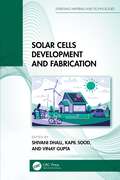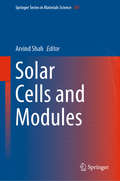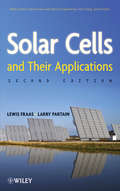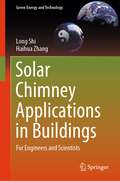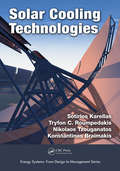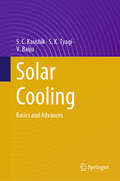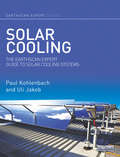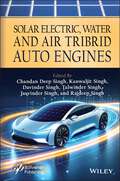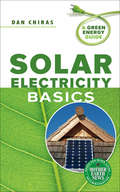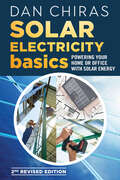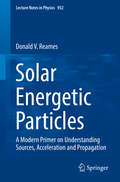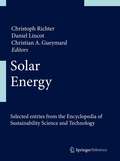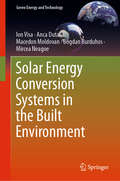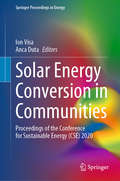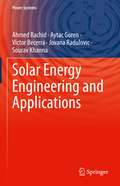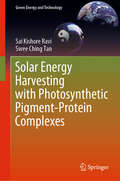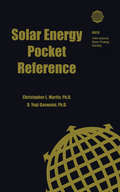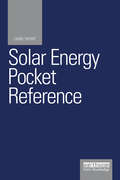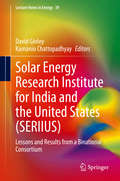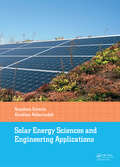- Table View
- List View
Solar Cells Development and Fabrication (Emerging Materials and Technologies)
by Vinay Gupta Shivani Dhall Kapil SoodThis book covers the basic scientific background of solar cells, their principles, working, growth, operating parameters, commercialization status, manufacturing challenges, and future scope of solar cells. Topics covered range from history and developments of solar cell generation to market growth and different applications of solar cells including in depth knowledge about Si, PSCs, and next generation multilayer bandgap based solar cells and their fabrication techniques with advanced methodology.Key features: Explains solar cells and their growth at different stages Discusses challenges in the fabrication/commercialization of solar cells at the lab and industry levels Combines fundamental, experimental, and theoretical knowledge with industrial needs and engineering design methods Covers the new generation of perovskite solar cells and their synthesis techniques Explores multilayer graded bandgap solar cells and their importance in existing solar technology This book is specifically designed for graduate students and researchers in solar energy technology, cell device, and materials science.
Solar Cells and Modules (Springer Series in Materials Science #301)
by Arvind ShahThis book gives a comprehensive introduction to the field of photovoltaic (PV) solar cells and modules. In thirteen chapters, it addresses a wide range of topics including the spectrum of light received by PV devices, the basic functioning of a solar cell, and the physical factors limiting the efficiency of solar cells. It places particular emphasis on crystalline silicon solar cells and modules, which constitute today more than 90 % of all modules sold worldwide. Describing in great detail both the manufacturing process and resulting module performance, the book also touches on the newest developments in this sector, such as Tunnel Oxide Passivated Contact (TOPCON) and heterojunction modules, while dedicating a major chapter to general questions of module design and fabrication. Overall, it presents the essential theoretical and practical concepts of PV solar cells and modules in an easy-to-understand manner and discusses current challenges facing the global research and development community.
Solar Cells and Their Applications
by Lewis M. Fraas Larry D. PartainA major update of solar cell technology and the solar marketplaceSince the first publication of this important volume over a decade ago, dramatic changes have taken place with the solar market growing almost 100-fold and the U.S. moving from first to fourth place in the world market as analyzed in this Second Edition. Three bold new opportunities are identified for any countries wanting to improve market position. The first is combining pin solar cells with 3X concentration to achieve economic competitiveness near term. The second is charging battery-powered cars with solar cell-generated electricity from arrays in surrounding areas-including the car owners' homes-while simultaneously reducing their home electricity bills by over ninety percent. The third is formation of economic "unions" of sufficient combined economic size to be major competitors.In this updated edition, feed-in tariffs are identified as the most effective approach for public policy. Reasons are provided to explain why pin solar cells outperform more traditional pn solar cells. Field test data are reported for nineteen percent pin solar cells and for ~500X concentrating systems with bare cell efficiencies approaching forty percent. Paths to bare cell efficiencies over fifty percent are described, and key missing program elements are identified. Since government support is needed for new technology prototype integration and qualification testing before manufacturing scale up, the key economic measure is identified in this volume as the electricity cost in cents per kilowatt-hour at the complete installed system level, rather than just the up-front solar cell modules' costs in dollars per watt.This Second Edition will benefit technologists in the fields of solar cells and systems; solar cell researchers; power systems designers; academics studying microelectronics, semiconductors, and solar cells; business students and investors with a technical focus; and government and political officials developing public policy.
Solar Cells: From Materials to Device Technology
by S. K. Sharma Khuram AliThis book addresses the rapidly developing class of solar cell materials and designed to provide much needed information on the fundamental principles of these materials, together with how these are employed in photovoltaic applications. A special emphasize have been given for the space applications through study of radiation tolerant solar cells. This book present a comprehensive research outlining progress on the synthesis, fabrication and application of solar cells from fundamental to device technology and is helpful for graduate students, researchers, and technologists engaged in research and development of materials.
Solar Cells: Types and Applications
by Sandeep Arya Prerna MahajanThis book highlights developments in the field of solar cells. The chapters in this book address a wide range of topics including the spectrum of light received by solar cell devices, the basic functioning of a solar cell, and the evolution of solar cell technology during the last 50 years. It places particular emphasis on silicon solar cells, CIGS-based solar cells, organic solar cells, perovskite solar cells and hybrid solar cells. The book describes in detail the fabrication processes employed for different categories of solar cells. It also provides the characterization techniques utilized in this sector to evaluate the performance of solar cells and the scope of this domain in the future. Overall, it presents the essential theoretical and practical concepts of solar cells in an easy-to-understand manner.
Solar Chimney Applications in Buildings: For Engineers and Scientists (Green Energy and Technology)
by Long Shi Haihua ZhangThis book comprehensively describes the operating principles and theoretical foundations of solar chimneys. It covers current research results, including numerical analysis and mathematical models based on different assumptions. Complying with the application of renewable energy in sustainable buildings, solar chimney has received extensive attention as an indispensable part natural ventilation. This book is a guide to the application of solar chimneys from single zones to multi zones, and it provides a reference source of application for construction practitioners and engineering decision-makers. The design basis and the related basic principles of fluid mechanics and natural ventilation design strategies introduced in this book will also be beneficial to college students.
Solar Cooling Technologies (Energy Systems)
by Sotirios Karellas Tryfon C Roumpedakis Nikolaos Tzouganatos Konstantinos BraimakisSolar Cooling Technologies presents a detailed study of the potential technologies for coupling solar energy and cooling systems. Unifies all the various power based solar techniques into one book, investigates tri-generation schemes for maximization of cooling efficiency, especially for small scale applications and offers direct comparison of all possible technologies of solar cooling Includes detailed numerical investigations for potential cooling applications
Solar Cooling: Basics and Advances
by S. C. Kaushik S. K. Tyagi V. BaijuThe book deals with the research activities focussed on solar VAD systems evaluating its merit of compatibility with ozone friendly refrigerants and adoptability with solar energy option. The authors of this book have given more emphasis on discussing various solar cooling VAD systems and its viability for the commercial use. Relevant references on "Solar Cooling: Basics and Advances" has been provided which significantly adopt some of the information for the completeness of the book.
Solar Cooling: The Earthscan Expert Guide to Solar Cooling Systems (Earthscan Expert)
by Paul Kohlenbach Uli JakobCooling buildings is a major global energy consumer and the energy requirement is growing year by year. This guide to solar cooling technology explains all you need to know about how solar energy can be converted into cooling energy. It outlines the difference between heat-driven and photovoltaic-driven systems and gives examples of both, making clear in what situations solar cooling technology makes sense. It includes chapters on: • solar thermal collectors • solar cooling technologies • cold distribution • storage components • designing and sizing • installation, operation and maintenance • economic feasibility • potential markets • case studies. Solar Cooling is for engineers, architects, consultancies, solar thermal technology companies, students and anyone who is interested in getting involved with this technology.
Solar Drying Systems
by Anil Kumar Om PrakashSolar energy has found its widespread use in direct conversion into electricity either by photovoltaic conversion or through thermal energy, reduction in post-harvest losses, and crop drying. Solar Drying Systems analyzes the fundamentals, principles and applications, heat transfer, elements of drying and solar dryer designs, and related modeling and analysis aspects of solar energy. Discusses both technical and policy-related issues Explores up-to-date status reviews of different solar drying systems Reviews the highlights of present and future solar drying options Includes many figures, solved examples, and tables with problems/exercises at the end of each chapter This book is aimed at senior undergraduate and graduate students in energy engineering.
Solar Electric Water and Air Tribrid Auto Engine
by Chandan Deep Singh Davinder Singh Talwinder Singh Kanwaljit Singh Jasvinder Singh Rajdeep SinghSolar Electric, Water and Air Tribrid Auto Engines is a must-have for anyone in the automotive industry, as it offers a comprehensive analysis of cutting-edge technologies that could revolutionize vehicle design and fuel efficiency, paving the way for a more sustainable future. This book analyzes the performance of solar electric, water, and air-based engines. These technologies can be combined to create the revolutionary tribrid engine that combines the three technologies to create an environmentally friendly automobile. Electric motors are known for their low emissions, and solar has the potential to amplify this ability. Water powered engines react with oxygen in the air to create fuel, causing fewer emissions and improved fuel economy. Compressed-air motors are pressure-driven, diminishing our reliance on fossil fuels. Their combined potential in the tribrid model presents revolutionary innovations for how we power automobiles. This volume provides an in-depth exploration of these technologies, providing an advanced understanding of their fundamentals and potential for combination in a tribrid model, making it essential for innovators in the automotive sector.
Solar Electricity Basics: A Green Energy Guide (Mother Earth News Books for Wiser Living)
by Dan ChirasThe future will be powered by renewables. As we transition away from finite and polluting fossil fuels, clean, reliable, and affordable renewable technologies such as solar electricity will become the mainstay of our energy supply. Solar Electricity Basics provides a clear understanding of electricity and energy. It discusses the types of solar electric system you can choose from, their components, solar site assessment, the installation of photovoltaic systems, and much more. Whether your goal is to lower your energy bill or to achieve complete energy independence, Solar Electricity Basics is the introduction you need.
Solar Electricity Basics: Powering Your Home or Office with Solar Energy
by Dan ChirasA guide to choosing and using solar electricity systems from &“the man who launched a thousand rooftop solar arrays . . . the essential go-to manual&” (John D. Ivanko and Lisa Kivirist, coauthors of ECOpreneuring). As we look for safer, more economical, and more sustainable ways to meet our needs for electricity—and as more and more electric cars hit the road—solar has become an increasingly popular option. With Solar Electricity Basics, renewable energy expert Dan Chiras offers a concise and up-to-date guide covering all the essentials. It explores:How to size, cost, and choose the right system, including off-grid vs. grid-tied vs. grid-tied with battery backupWhere to mount a system for maximum performanceWhat type of modules and inverters to buyHow to install and maintain batteriesCost vs. benefit for solar electric systemsHow to connect to the grid, and what type of net metering your area offersSolar Electricity Basics is an indispensable guide for homeowners, business owners, builders, and students for figuring out solar electricity quickly and easily.
Solar Energetic Particles
by Donald V. ReamesThis concise primer introduces the non-specialist reader to the physics of solar energetic particles (SEP) and systematically reviews the evidence for the two main mechanisms which lead to the so-called impulsive and gradual SEP events. More specifically, the timing of the onsets, the longitude distributions, the high-energy spectral shapes, the correlations with other solar phenomena (e. g. coronal mass ejections), as well as the all-important elemental and isotopic abundances of SEPs are investigated. Impulsive SEP events are related to magnetic reconnection in solar flares and jets. The concept of shock acceleration by scattering on self-amplified Alfv#65533;n waves is introduced, as is the evidence of reacceleration of impulsive-SEP material in the seed population accessed by the shocks in gradual events. The text then develops processes of transport of ions out to an observer. Finally, a new technique to determine the source plasma temperature in both impulsive and gradual events is demonstrated. Last but not least the role of SEP events as a radiation hazard in space is mentioned and a short discussion of the nature of the main particle telescope designs that have contributed to most of the SEP measurements is given.
Solar Energy
by Christian A. Gueymard Christoph Richter Daniel LincotGathering some 30 entries from the Encyclopedia of Sustainability Science and Technology, this book presents fundamental principles and technologies for sustainably harnessing solar energy. Covers photovoltaics, solar thermal energy, solar radiation and more.
Solar Energy (Let's Explore Global Energy Ser.)
by David ArmentroutIntroduces Solar Energy and its positive or negative impact on the environment, particularly our future. <P><P>Lexile Measure: 950L
Solar Energy Conversion Systems in the Built Environment (Green Energy and Technology)
by Ion Visa Anca Duta Macedon Moldovan Bogdan Burduhos Mircea NeagoeThis book focuses on solar energy conversion systems that can be implemented in the built environment, at building or at community level. The quest for developing a sustainable built environment asks for specific solutions to provide clean energy based on renewable sources, and solar energy is considered one of the cleanest available energy on Earth. The specific issues raised by the implementation location are discussed, including the climatic profile distorted by the buildings, the available surface on the buildings for implementation, etc. This book also discusses the seasonal and diurnal variability of the solar energy resource in parallel with the variability of the electrical and thermal energy demand in the built environment (particularly focusing on the residential buildings). Solutions are proposed to match these variabilities, including the development of energy mixes with other renewables (e.g. geothermal or biomass, for thermal energy production). Specific solutions, including case studies of systems implemented on buildings all over the world, are presented and analyzed for electrical and for thermal energy production and the main differences in the systems design are outlined. The conversion efficiency (thus the output) and the main causes of energy losses are considered in both cases. The architectural constraints are additionally considered and novel solar energy convertors with different shapes and colors are presented and discussed. The durability of the solar energy conversion systems is analyzed considering the specific issues that occur when these systems are implemented in the built environment; based on practical examples, general conclusions are formulated and specific aspects are discussed in relation to experimental results and literature data. With renewables implemented in the built environment likely to expand in the near future, this book represents welcome and timely material for all professionals and researchers that are aiming to provide efficient and feasible solutions for the sustainable built environment.
Solar Energy Conversion and Storage: Photochemical Modes (Electrochemical Energy Storage and Conversion)
by Suresh C. Ameta Rakshit AmetaSolar Energy Conversion and Storage: Photochemical Modes showcases the latest advances in solar cell technology while offering valuable insight into the future of solar energy conversion and storage. Focusing on photochemical methods of converting and/or storing light energy in the form of electrical or chemical energy, the book:Describes various t
Solar Energy Conversion in Communities: Proceedings of the Conference for Sustainable Energy (CSE) 2020 (Springer Proceedings in Energy)
by Ion Visa Anca DutaThis book presents novel findings concerning the systems, materials and processes used in solar energy conversion in communities. It begins with the core resource – solar radiation – and discusses the restrictions on the wide-scale implementation of conversion systems imposed by the built environment, as well as potential solutions. The book also describes efficient solar energy conversion in detail, focusing on heat and electricity production in communities and water reuse. Lastly, it analyzes the concept of sustainable communities, presenting examples from around the globe, along with novel approaches to improving their feasibility and affordability. Though chiefly intended for professionals working in the field of sustainability at the community level, the book will also be of interest to researchers, academics and doctoral students.
Solar Energy Engineering and Applications (Power Systems)
by Ahmed Rachid Aytac Goren Victor Becerra Jovana Radulovic Sourav KhannaSolar Energy Engineering and Applications gives a general and concise presentation of solar energy from a practical engineering perspective. The book provides readers with a comprehensive, accessible, and intuitive introduction to proven methods and tools for the design, implementation, and monitoring of solar energy systems and associated auxiliary technologies without covering detailed in-depth physics. Coverage includes key aspects of solar energy such as photovoltaic solar cells and systems, battery technologies, solar concentrators, and hybrid photovoltaic/thermal systems. Application areas such as homes, buildings, solar farms, street lighting, vehicles, and dryers are discussed. The methods for connecting solar farms and other photovoltaic installations to power distribution systems are explored in the context of smart grid technologies that are available to facilitate such connections. The book will be a valuable professional reference for practicing engineers and researchers involved in the applications of solar energy.
Solar Energy Harvesting with Photosynthetic Pigment-Protein Complexes (Green Energy and Technology)
by Swee Ching Tan Sai Kishore RaviThis book chronicles a few approaches to constructing biohybrid devices using photosynthetic protein complexes. Can the abundantly available solar energy be tapped to meet our rising energy demands using green and cheap active materials? Exploring nature’s own tiny solar factories, the photosynthetic proteins could hold the key. Photosynthetic pigment-protein complexes found in plants and certain types of bacteria transduce sunlight into biologically useful forms of energy through a photochemical charge separation that has a 100% quantum efficiency. Getting the photoproteins to perform this efficient energy conversion reaction in a semi-artificial setup is central to developing biohybrid solar technologies, a promising green alternative to today’s photovoltaics. This book looks into the existing challenges and opportunities in the field of biohybrid photovoltaics and provides a few prospective methods of enhancing the photocurrent and photovoltage in these devices. The book targets the readership of students, academics, and industrial practitioners who are interested in alternative solar technologies.
Solar Energy Pocket Reference (Energy Pocket Reference Ser.)
by D. Yogi Goswami Christopher L. MartinDrawing on the experience of some of the foremost experts in the field, this easy-to-use and affordable pocket reference includes a wealth of information relating to solar energy and solar energy technologies. Topics covered range from solar angles, sun path diagrams, solar radiation and radiative properties of materials through to thermal collectors, thermal energy storage, photovoltaics and daylighting. The book also includes conversion factors and constants and is peppered throughout with helpful illustrations, equations and explanations. Anyone with an interest in solar energy, including professional architects and engineers, home builders, academic researchers, students and energy consultants will find a host of answers in this book – a practical assimilation of data, fundamentals and guidelines for application.
Solar Energy Pocket Reference: Second edition (Energy Pocket Reference)
by David ThorpeThis handy pocket reference provides a wealth of practical information relating to solar energy and solar energy technologies. Topics covered include solar radiation and its detailed measurement, the emissivity and absorption properties of materials, solar thermal energy collection and storage, photovoltaics (both at all scales), solar cooling, and the use of solar energy for desalination and drying. The book also includes conversion factors, standards and constants and is peppered throughout with helpful illustrations, equations and explanations, as well as a chapter making the business case for solar power. Anyone with an interest in solar energy, including energy professionals and consultants, engineers, architects, academic researchers and students, will find a host of answers in this book – a practical assimilation of fundamentals, data, technologies and guidelines for application.
Solar Energy Research Institute for India and the United States: Lessons and Results from a Binational Consortium (Lecture Notes in Energy #39)
by David Ginley Kamanio ChattopadhyayThis book describes the development, functioning, and results of a successful binational program to promote significant scientific advances in Earth-abundant photovoltaics (PV) and concentrated solar power (CSP), advanced process/manufacturing technologies, multiscale modeling and reliability testing, and analysis of integrated solar energy systems. SERIIUS is a consortium between India and the United States dedicated to developing new solar technologies and assessing their potential impact in the two countries. The consortium consists of nearly 50 institutions including academia, national laboratories, and industry, with the goal of developing significant new technologies in all areas of solar deployment. In addition, the program focused on workforce development through graduate students, post-doctoral students, and an international exchange program. Particular emphasis was placed on the following efforts: Creating disruptive technologies in PV and CSP through high-impact fundamental and applied research and development (R&D). Identifying and quantifying the critical technical, economic, and policy issues for solar energy development and deployment in India. Overcoming barriers to technology transfer by teaming research institutions and industry in an effective project structure. Building a new platform for binational collaboration using a formalized R&D project structure, along with effective management, coordination, and decision processes. Creating a sustainable network and workforce development program from which to build large collaborations and fostering a collaborative culture and outreach programs. This includes using existing and new methodologies for collaboration based on advanced electronic and web-based communication to facilitate functional international teams. The book summarizes the general lessons learned from these experiences.
Solar Energy Sciences and Engineering Applications
by Napoleon Enteria Aliakbar AkbarzadehSolar energy is available all over the world in different intensities. Theoretically, the solar energy available on the surface of the earth is enough to support the energy requirements of the entire planet. However, in reality, progress and development of solar science and technology depends to a large extent on human desires and needs. This is du
